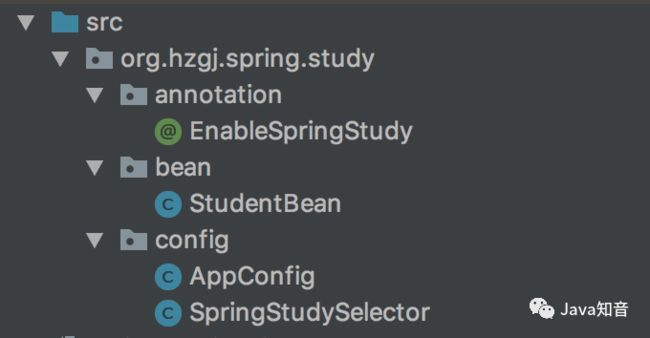深入理解Spring的ImportSelector接口
![]()
作者:聂晨
cnblogs.com/niechen/p/9262452.html
ImportSelector接口是至spring中导入外部配置的核心接口,在SpringBoot的自动化配置和@EnableXXX(功能性注解)都有它的存在,关于SpringBoot的分析可以参考:深入理解SpringBoot的自动装配。
一、关于ImportSelector接口
package org.springframework.context.annotation;
import org.springframework.core.type.AnnotationMetadata;
/**
* Interface to be implemented by types that determine which @{@link Configuration}
* class(es) should be imported based on a given selection criteria, usually one or more
* annotation attributes.
*
* An {@link ImportSelector} may implement any of the following
* {@link org.springframework.beans.factory.Aware Aware} interfaces, and their respective
* methods will be called prior to {@link #selectImports}:
*
* - {@link org.springframework.context.EnvironmentAware EnvironmentAware}
* - {@link org.springframework.beans.factory.BeanFactoryAware BeanFactoryAware}
* - {@link org.springframework.beans.factory.BeanClassLoaderAware BeanClassLoaderAware}
* - {@link org.springframework.context.ResourceLoaderAware ResourceLoaderAware}
*
*
* ImportSelectors are usually processed in the same way as regular {@code @Import}
* annotations, however, it is also possible to defer selection of imports until all
* {@code @Configuration} classes have been processed (see {@link DeferredImportSelector}
* for details).
*
* @author Chris Beams
* @since 3.1
* @see DeferredImportSelector
* @see Import
* @see ImportBeanDefinitionRegistrar
* @see Configuration
*/
public interface ImportSelector {
/**
* Select and return the names of which class(es) should be imported based on
* the {@link AnnotationMetadata} of the importing @{@link Configuration} class.
*/
String[] selectImports(AnnotationMetadata importingClassMetadata);
}
该接口文档上说的明明白白,其主要作用是收集需要导入的配置类,如果该接口的实现类同时实现EnvironmentAware, BeanFactoryAware ,BeanClassLoaderAware或者ResourceLoaderAware,那么在调用其selectImports方法之前先调用上述接口中对应的方法,如果需要在所有的@Configuration处理完在导入时可以实现DeferredImportSelector接口。
在这里我举个Spring中的实例来看一下:
@Target(ElementType.TYPE)
@Retention(RetentionPolicy.RUNTIME)
@Documented
@Import(TransactionManagementConfigurationSelector.class)
public @interface EnableTransactionManagement {
/**
* Indicate whether subclass-based (CGLIB) proxies are to be created ({@code true}) as
* opposed to standard Java interface-based proxies ({@code false}). The default is
* {@code false}. Applicable only if {@link #mode()} is set to
* {@link AdviceMode#PROXY}.
* Note that setting this attribute to {@code true} will affect all
* Spring-managed beans requiring proxying, not just those marked with
* {@code @Transactional}. For example, other beans marked with Spring's
* {@code @Async} annotation will be upgraded to subclass proxying at the same
* time. This approach has no negative impact in practice unless one is explicitly
* expecting one type of proxy vs another, e.g. in tests.
*/
boolean proxyTargetClass() default false;
/**
* Indicate how transactional advice should be applied. The default is
* {@link AdviceMode#PROXY}.
* @see AdviceMode
*/
AdviceMode mode() default AdviceMode.PROXY;
/**
* Indicate the ordering of the execution of the transaction advisor
* when multiple advices are applied at a specific joinpoint.
* The default is {@link Ordered#LOWEST_PRECEDENCE}.
*/
int order() default Ordered.LOWEST_PRECEDENCE;
}
此注解是开启声明式事务的注解,那么它的@Import所导入的类为TransactionManagementConfigurationSelector,那么我们看一下其类图:
由此可知该类实现类ImportSelector接口
二、自定义@EnableXXX注解
在这里我们先准备两个Spring的项目工程:spring-project与ssm-project,其中spring-project里我们先创建好如下结构目录:
SpringStudySelector
package org.hzgj.spring.study.config;
import org.springframework.beans.BeansException;
import org.springframework.beans.factory.BeanFactory;
import org.springframework.beans.factory.BeanFactoryAware;
import org.springframework.context.annotation.ImportSelector;
import org.springframework.core.type.AnnotationMetadata;
public class SpringStudySelector implements ImportSelector, BeanFactoryAware {
private BeanFactory beanFactory;
@Override
public String[] selectImports(AnnotationMetadata importingClassMetadata) {
importingClassMetadata.getAnnotationTypes().forEach(System.out::println);
System.out.println(beanFactory);
return new String[]{AppConfig.class.getName()};
}
@Override
public void setBeanFactory(BeanFactory beanFactory) throws BeansException {
this.beanFactory = beanFactory;
}
}
在这里我们实现ImportSelector接口和BeanFactoryAware接口,重写selectImports方法,最后我们返回的是AppConfig的类名,同时打印出相关的注解元数据与BeanFactory
自定义@EnableSpringStudy注解
package org.hzgj.spring.study.annotation;
import org.hzgj.spring.study.config.SpringStudySelector;
import org.springframework.context.annotation.Import;
import java.lang.annotation.*;
@Retention(RetentionPolicy.RUNTIME)
@Documented
@Target(ElementType.TYPE)
@Import(SpringStudySelector.class)
public @interface EnableSpringStudy {
}
在这里我们仿照@EnableTransactionManagement来实现自定义注解,注意使用@Import导入我们刚才写的SpringStudySelector
AppConfig
package org.hzgj.spring.study.config;
import org.hzgj.spring.study.bean.StudentBean;
import org.springframework.context.annotation.Bean;
import org.springframework.context.annotation.Configuration;
@Configuration
public class AppConfig {
@Bean
public StudentBean studentBean() {
StudentBean studentBean = new StudentBean();
studentBean.setId(19);
studentBean.setName("admin");
return studentBean;
}
}
当都完成以后我们打个jar包,准备引入至其他工程:
完成ssm-project工程中的AppConfig配置类
1) 首先我们将刚才的spring.jar导入到ssm-project工程里
2) 在对应的配置类上添加上spring-project中定义的@EnableSpringStudy注解
@Configuration //表明此类是配置类
@ComponentScan // 扫描自定义的组件(repository service component controller)
@PropertySource("classpath:application.properties") // 读取application.properties
@MapperScan("com.bdqn.lyrk.ssm.study.app.mapper") //扫描Mybatis的Mapper接口
@EnableTransactionManagement //开启事务管理
@EnableSpringStudy
public class AppConfig {
//....省略配置代码
}
3)编写Main方法
public static void main(String[] args) throws IOException {
AnnotationConfigApplicationContext applicationContext = new AnnotationConfigApplicationContext(AppConfig.class);
StudentBean studentBean = applicationContext.getBean(StudentBean.class);
System.out.println(studentBean.getName());
}
运行后输出结果:
org.springframework.context.annotation.Configuration
org.springframework.context.annotation.ComponentScan
org.springframework.context.annotation.PropertySource
org.mybatis.spring.annotation.MapperScan
org.springframework.transaction.annotation.EnableTransactionManagement
org.hzgj.spring.study.annotation.EnableSpringStudy
org.springframework.beans.factory.support.DefaultListableBeanFactory@4b9e13df: defining beans [org.springframework.context.annotation.internalConfigurationAnnotationProcessor,org.springframework.context.annotation.internalAutowiredAnnotationProcessor,org.springframework.context.annotation.internalRequiredAnnotationProcessor,org.springframework.context.annotation.internalCommonAnnotationProcessor,org.springframework.context.event.internalEventListenerProcessor,org.springframework.context.event.internalEventListenerFactory,appConfig,propertiesConfig,logAspect,studentService]; root of factory hierarchy
admin
从这里我们可以看到ImportSelector接口中的方法参数,可以获取ssm-project项目下AppConfig的所有注解,并且能够获取当前BeanFactory所有配置的Bean
三、ImportSelector源码分析
这个接口在哪里调用呢?我们可以来看一下ConfigurationClassParser这个类的processImports方法
private void processImports(ConfigurationClass configClass, SourceClass currentSourceClass,
Collection importCandidates, boolean checkForCircularImports) {
if (importCandidates.isEmpty()) {
return;
}
if (checkForCircularImports && isChainedImportOnStack(configClass)) {
this.problemReporter.error(new CircularImportProblem(configClass, this.importStack));
}
else {
this.importStack.push(configClass);
try {
for (SourceClass candidate : importCandidates) {
//对ImportSelector的处理
if (candidate.isAssignable(ImportSelector.class)) {
// Candidate class is an ImportSelector -> delegate to it to determine imports
Class candidateClass = candidate.loadClass();
ImportSelector selector = BeanUtils.instantiateClass(candidateClass, ImportSelector.class);
ParserStrategyUtils.invokeAwareMethods(
selector, this.environment, this.resourceLoader, this.registry);
if (this.deferredImportSelectors != null && selector instanceof DeferredImportSelector) {
//如果为延迟导入处理则加入集合当中
this.deferredImportSelectors.add(
new DeferredImportSelectorHolder(configClass, (DeferredImportSelector) selector));
}
else {
//根据ImportSelector方法的返回值来进行递归操作
String[] importClassNames = selector.selectImports(currentSourceClass.getMetadata());
Collection importSourceClasses = asSourceClasses(importClassNames);
processImports(configClass, currentSourceClass, importSourceClasses, false);
}
}
else if (candidate.isAssignable(ImportBeanDefinitionRegistrar.class)) {
// Candidate class is an ImportBeanDefinitionRegistrar ->
// delegate to it to register additional bean definitions
Class candidateClass = candidate.loadClass();
ImportBeanDefinitionRegistrar registrar =
BeanUtils.instantiateClass(candidateClass, ImportBeanDefinitionRegistrar.class);
ParserStrategyUtils.invokeAwareMethods(
registrar, this.environment, this.resourceLoader, this.registry);
configClass.addImportBeanDefinitionRegistrar(registrar, currentSourceClass.getMetadata());
}
else {
// 如果当前的类既不是ImportSelector也不是ImportBeanDefinitionRegistar就进行@Configuration的解析处理
// Candidate class not an ImportSelector or ImportBeanDefinitionRegistrar ->
// process it as an @Configuration class
this.importStack.registerImport(
currentSourceClass.getMetadata(), candidate.getMetadata().getClassName());
processConfigurationClass(candidate.asConfigClass(configClass));
}
}
}
catch (BeanDefinitionStoreException ex) {
throw ex;
}
catch (Throwable ex) {
throw new BeanDefinitionStoreException(
"Failed to process import candidates for configuration class [" +
configClass.getMetadata().getClassName() + "]", ex);
}
finally {
this.importStack.pop();
}
}
}
在这里我们可以看到ImportSelector接口的返回值会递归进行解析,把解析到的类全名按照@Configuration进行处理
END
Java面试题专栏
【61期】MySQL行锁和表锁的含义及区别(MySQL面试第四弹)
【62期】解释一下MySQL中内连接,外连接等的区别(MySQL面试第五弹)
【63期】谈谈MySQL 索引,B+树原理,以及建索引的几大原则(MySQL面试第六弹)
【64期】MySQL 服务占用cpu 100%,如何排查问题? (MySQL面试第七弹)
【65期】Spring的IOC是啥?有什么好处?
【66期】Java容器面试题:谈谈你对 HashMap 的理解
【67期】谈谈ConcurrentHashMap是如何保证线程安全的?
【68期】面试官:对并发熟悉吗?说说Synchronized及实现原理
【69期】面试官:对并发熟悉吗?谈谈线程间的协作(wait/notify/sleep/yield/join)
【70期】面试官:对并发熟悉吗?谈谈对volatile的使用及其原理
![]()
我知道你 “在看”


